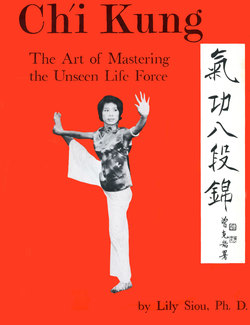Читать книгу Chi Kung - Lily Siou - Страница 7
На сайте Литреса книга снята с продажи.
ОглавлениеAuthoress'es Forword
Through the ages, the Chinese have developed many valuable arts and practices. However, through the course of time, some of these arts have been completely or partially lost to the modern world, leaving behind often times, only their Chinese characters and a vague idea of what it was. Ch'i Kung is one example. Ch'i Kung an ancient but profound body and mind discipline embodying much of Chinese philosophy was once a subject of much study in China. Boxers of the Wei Dynasty firmly upheld that systematic breathing control, Ch'i Kung, led to better Kung Fu. Ch'i Kung is believed to be responsible for the brilliant and active development of Chinese martial arts at this time. But today it survives mainly through the practice of a very few. Books on Ch'i Kung are only a handful. The Library of Congress reports that there is no work on Ch'i Kung in English. Even in Chinese there is little on the subject, just bits and pieces of material or very small books on it. In writing about Ch'i Kung, therefore, I am forced to rely largely on my knowledge and understanding about it gained through my years of study with the Taoist monks. I hope that this book as a first seed in the Western world will grow and flourish for the benefit of all. Through it, I hope to show the way to better health and well being through the natural movements of Ch'i Kung and to further the understanding of philosophies of the East and West. Through my School of the Six Chinese Arts, I hope to do the same.
In the summer of 1970, I brought four books written by myself into the Western world with the hope that they could be of some use here. These books were on the I Ching, Chinese herbs, acupuncture and cauterization and on Ch'i Kung. These works have aided me in my lectures and should be of interest to anyone curious about the Chinese.
It is this last book together with the works of Hua T'o that have constituted the major literary resources available. Hua T'o of the Three Kingdoms, one of the greatest physicians of all times was the first exponent of systematic exercises and Ch'i Kung. He developed a systematic exercise called the "Playing of the Five Animals" ( ).
Most of his works were destroyed by time and what have been handed down to the present are only two books on the subject. On is called PA TUEN CHIN ( ) meaning "eight precious chapters" and it is translated into the Eight Silken Forms. The other is called I CHING CHING ( ) meaning "the canon of the changing muscles". Many books mention and refer to Ch'i Kung but these are about all the books there are on Ch'i Kung in Chinese.
In writing this work, I owe much to many people. Many teachers, doctors, friends and students assisted me in completing the work for publication. I would like to acknowledge Dr. C. C. Hu, M. D., Kiangsi Province Divisional Hospital, China, for many valuable ideas gained from his lectures. As literary advisors on the theory and philosophy of Ch'i Kung and the inter-relationship of the yin and the yang, I would like to thank former professor I Ju Chen of St. John's University of Shanghai, Professor Ke-Tuan Tseng of the Chinese University of Hong Kong. For material and outline on the concept of Chinese healing I am grateful to Dr. S. T. Hsiao, surgeon, Kiangsu Divisional Hospital and Dr. S. C. Hsiao, herbalist, Central Hospital of Chinese Medicine, Chiangso Province, China.
For generous support and help on breathing control and Chinese martial arts, I am grateful to William K. W. Hu, a very qualified martial artist with fifteen years of serious dedicated training. For her experiences as a Ch'i Kung practitioner, I thank Christine Sueda, graduate, student at the University of Hawaii. The arrows showing the movements were drawn by Edgar Ng, a very talented artist who sacrificed much of his time in order to do a better job.
Instructions for the sitting forms were written by Walter Y. S. Pang, a recent graduate of the University of Hawaii and a young man with much internal beauty. Instructions for the standing forms were written by Francis Pang, another graduate student at the University of Hawaii.
For the photographs, I am grateful to Delwin Ching, Dai Yen Loo, Calvin Chee and William Hee Jr.
For a great amount of time spent in editing, I am indeed grateful to Kevin Wakayama, of Columbia University.
Mrs. Arlene Luster deserve special thanks for the great amount of paper work and bibliographic searches she so generously did.
Many others have spent much time supporting this work. These people include Raymond Young, Thomas Zane, Dr. C. W. Hsu and many others.
Most importantly, I would like to thank my master, S. F. Chang for the ten years of training he has given me, his encouragement and continued guidance in the theoretical and practical aspects of Ch'i Kung. He told me always:
Ch'Ih te K'u chung K'u
Fang wei jen shang jen
One who can taste the bitterest of bitterness is one who can be a man above men.
Lily Siou
